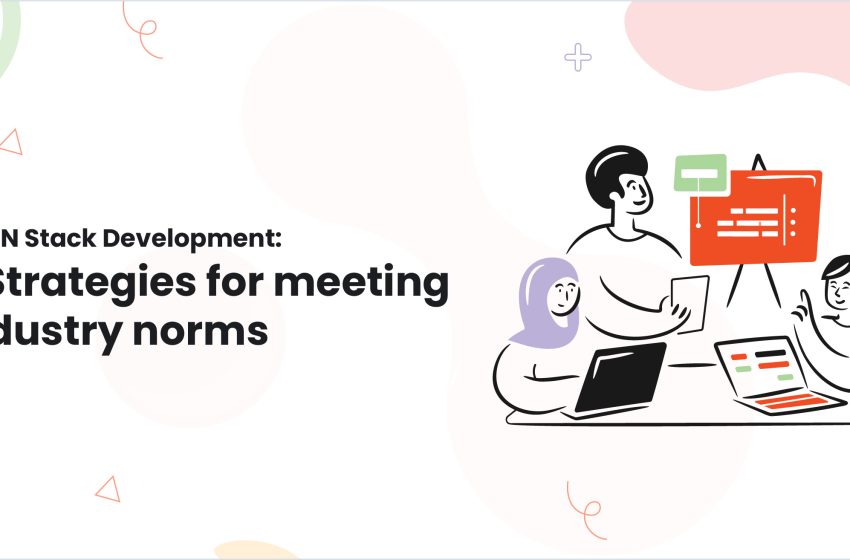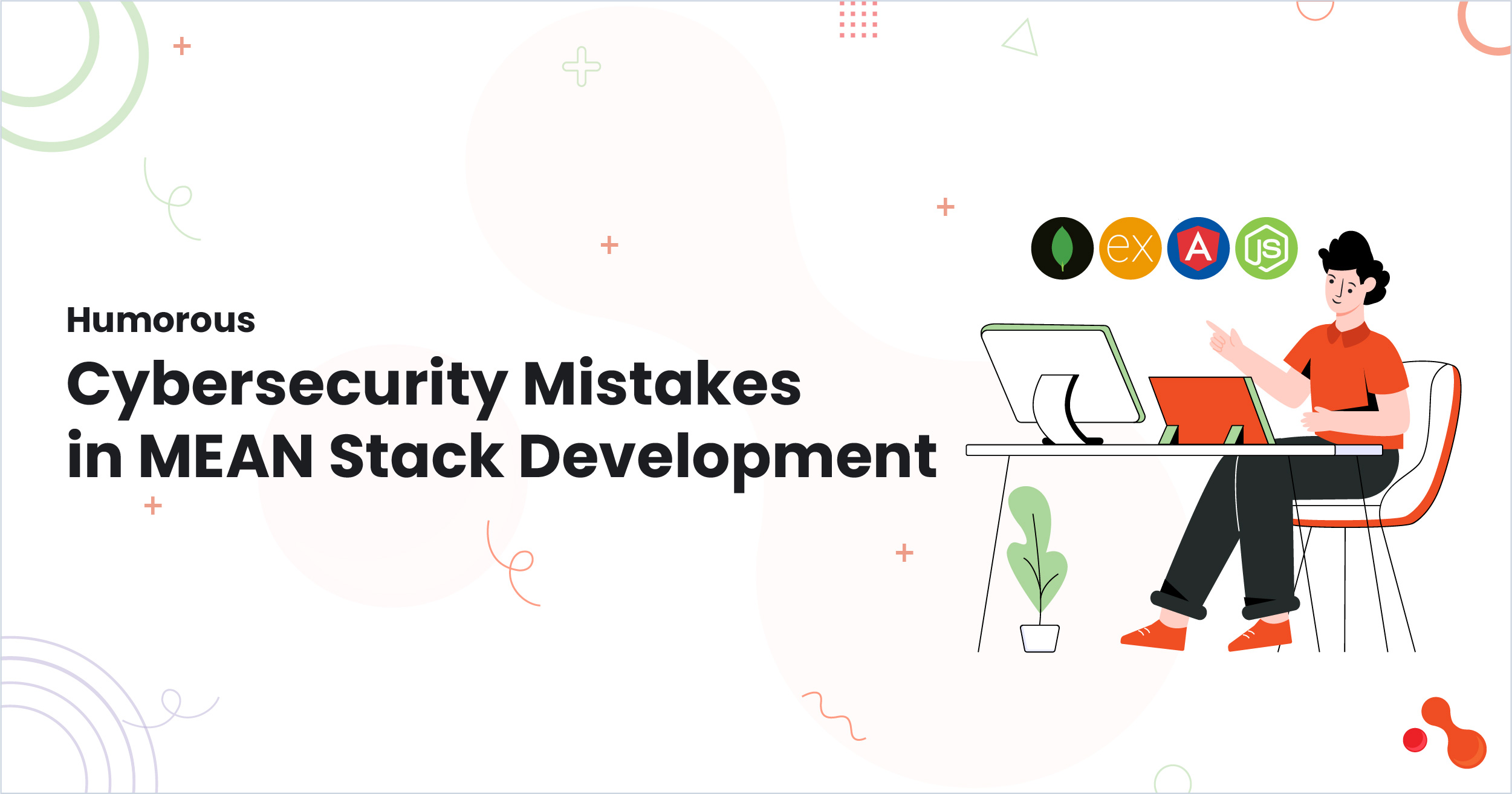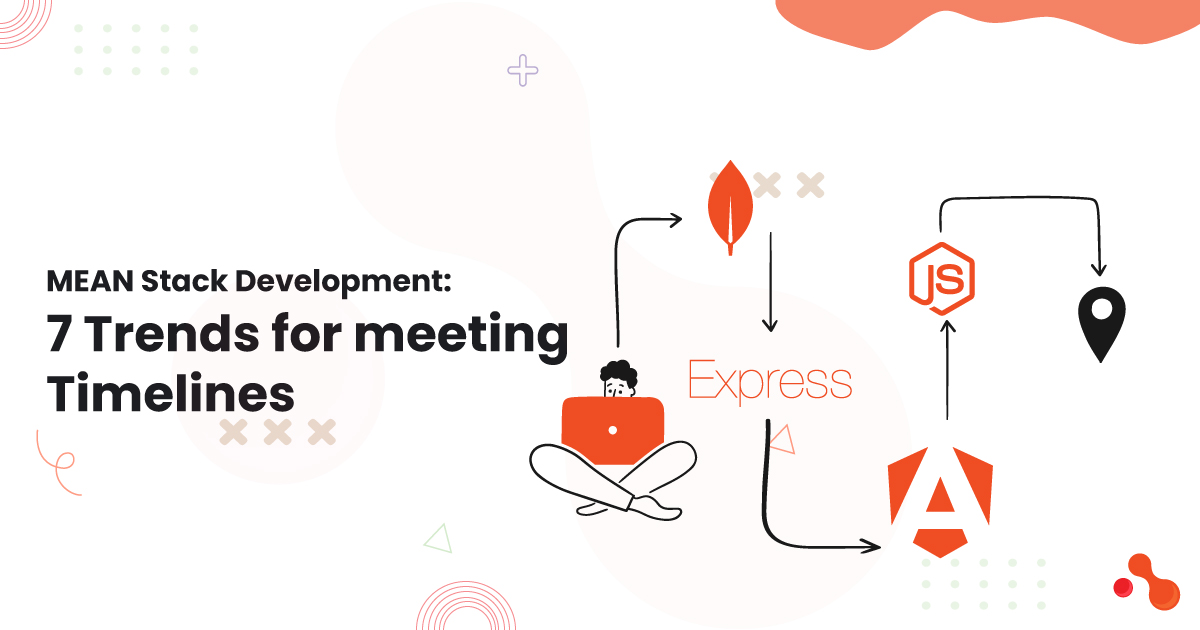MEAN Stack Development: 8 Strategies for meeting industry norms

Introduction
Today’s competitive landscape invites businesses to rise above standards set by any other, so as to make a niche for themselves in the market. The MEAN stack development is a combination of technologies such as MongoDB, Express.js, Angular, and Node.js. Leading and setting new benchmarks requires industry standards, strategic plans, innovative thoughts, and strong policies that ensure emphasis on quality.
This article discusses some secret strategies that will help an organization lead the front and set new benchmarks in MEAN development.
Let’s begin by understanding what is MEAN Stack Development
What is MEAN Stack Development?
The MEAN stack is a well-known full-stack JavaScript framework for dynamic web applications. It consists of four technologies:
- MongoDB: A NoSQL database for persisting data for an application
- Express.js: A web app framework for Node.js
- Angular.js: A front end framework to implement a dynamic user interface
- Node.js: A lossless and open-source JavaScript runtime used for executing your code on the server
The ability to utilize a single language across your stack (from your database to your front end) allows for easier development, as well as the ability to reuse code. It is mainly for building cloud-hosted web applications that can also be scalable.
Now, further let us talk about the Advantages of MEAN Stack Development
Advantages of Developing in MEAN Stack
Some fundamental advantages for using MEAN stack are:
- Flexibility: Because the components in MEAN stack are loosely coupled, they can be swapped out individually.
- Scalability: MongoDB and Node.js can easily scale to meet high-volume data and traffic.
- Productivity: In each tier, developers need to know only JavaScript (as opposed to using languages that span multiple).
- Cost: MEAN stack is open-source and no licensing fee.
- Rapid Prototyping: A developer’s toolkit demonstrating how quickly they can iterate and deploy an app.
Further, let us talk about the architecture of MEAN Stack Development
MEAN Stack Development Architecture
MEAN stack follows a traditional three tier architecture:
- Presentation Tier: Front End UI and client-side covered in Angular
- Application Tier: Server-side application powered with Express.js and Node.js
- Data tier: Data that is stored and retrieved by the application is driven with MongoDB
Future communication/messages from Angular -> Express -> MongoDB, form of HTTP requests. Express -> Angular, return to Angular, messages: verified. Expressjs -> MongoDB, returns app data to send back to Angular.
Now, moving next let us discuss the components of MEAN Stack development
Components of MEAN Stack development
Let’s take a closer look at each piece of the MEAN stack:
- MongoDB: A NoSQL database that stores data in flexible, JSON-like documents. Designed for scalability and high availability.
- Express.js: A minimal and flexible Node.js web application framework that provides a robust set of features for web and mobile applications.
- Angular: A TypeScript-based, open-source web application framework for building single-page applications. Follows the Model-View-Controller (MVC) architectural pattern.
- Node.js: An open-source, cross-platform JavaScript runtime environment that executes JavaScript code outside of a browser. Used for server-side scripting to build network applications.
MEAN Stack Use Cases
The MEAN stack is applicable to a diverse array of web application types:
- Single Page Applications (SPAs): Angular is adept at producing fast, responsive SPAs.
- Real-time Applications: Node.js and WebSockets facilitate speedy real-time experience.
- Data-heavy Applications: MongoDB’s non-rigid schema is excellent for unstructured data.
- Microservices: Reliant on Node.js and Express, it simplifies developing modular microservices.
Moving next, let us understand the drawbacks of MEAN Stack development
Disadvantages of MEAN Stack
MEAN offers a good number of benefits; however, there are also some potential downsides to keep in mind:
- Steep Learning Curve: Learning Angular, MongoDB, and Node.js may present a steep learning curve for developers.
- Immaturity: Some MEAN components may be relatively new compared to other alternatives.
- Monolithic Architecture: Without some care and thought into architecture, MEAN applications can easily become monolithic.
- Performance: JavaScript’s single-threaded nature, combined with how MEAN apps are built, can inhibit performance at scale.
Further, let’s talk about the alternatives of MEAN Stack Development
Alternatives to MEAN Stack Development
There are many alternatives to a MEAN staking using different front-end frameworks:
- MERN: Turns Angular into React.js–which is an increasingly popular UI library to work with.
- MEVN: Utilizes a front-end framework Vue.js to be more lightweight and faster than Angular.
- LAMB: A stack which includes Laravel, AngularJS, MongoDB, and Bootstrap.
- PERN: Attaches Express and Node to the relational database system, PostgreSQL.
Ultimately, the decision to go with MEAN or any of these alternatives depends on many variables like team considerations, project specifications, and personal preference.
Also read the detailed article on MEAN vs MERN vs MEVN: A three-way Web-app development Tussle
8 Strategies to surpass MEAN industry Standards
Certain ways an organization can excel in MEAN Stack Development and stay ahead of the competition are listed below:
Strategy 1: Stress on Quality Assurance Quality assurance or QA is the backbone of a development project.
In the case of MEAN Stack Development, strong QA makes the tangible product quality and reliability very strong. How?
- Automation Testing: Leverage automated testing tools like Jasmine, Mocha, and Protractor to speed up the testing process. Ensure your applications have no bugs and are performing optimally.
- Continuous Integration/Continuous Deployment: CI/CD pipelines can be deployed with the help of separate tools in order to automate the processes of integration and deployment. This helps speed up development while reducing manual deployment errors.
- UAT – User Acceptance Testing: this test involves end-users as well to gather feedback whether the application can meet the needs and expectations.
Strategy 2: Create a Culture of Innovation Innovation is performing better than the set standards of the industry.
Organizations need to create an environment where creative thinking is nurtured along with experimentation. Following are some ways innovation can be created:
- Encourage collaboration: Collaboration between cross-functional development, design, and marketing teams is beneficial. Diversity brings about innovative solutions and better products.
- Invest in Training: Invest in the training and development of your team. Keep them updated with the latest technologies and trends in MEAN stack development so that they can innovate.
- Allow Time for Experimentation: Give developers time to experiment with projects that may be considered a little off-track. This may be how you come upon those groundbreaking ideas that will revolutionize your product.
Strategy 3: Focus on User Experience (UX)
In the world of MEAN stack development, the user experience is the most important. A smooth and delightful UX can give your application a competitive edge.
Here’s how to ensure you develop with UX in mind:
- Conduct user research: Make an effort to meet with users frequently to identify their wants, needs, and pain points. Use this information as a backdrop when it comes to making design and development decisions.
- Employ responsive design: Make sure your applications are mobile-ready and, ideally, that the experience is consistent across devices. Frameworks such as bootstrapping and Angular Material can effectively reinforce responsive design.
- Optimize performance: An entire UX is hindered if an application is slow to load, interaction fizzles, etc. Make sure to give thought and energy to your application’s performance such as how quickly it loads, how well it responds to clicks/inputs/changes, etc. Some strategies engineers use to optimize performance include lazy loading and splitting code into manageable chunks.
Strategy 4: Use Data to Drive Decisions
When it comes to informing business strategy and improving products, data is at the heart of systems. Organizations can harness the power of analytics to back up data-driven decision making, which will lead to successful outcomes.
Here’s how to embrace data-driven decision making:
- Use analytics: Consider adopting tools such as Google Analytics or Mixpanel to track user behavior and application performance. You can sift through and analyze the collected data, and fit the summary into grouped bucket categories, trends, or ideas for improvement.
- A/B, and even C testing: Testing can yield even richer options. Consider conducting duplicate testing to measure multiple versions of a single feature or layout option. Having three options will increase your chances of success (for users and business goals).
- Feedback loops: Feedback loops will also assist in learning and discovery and weighting the above decisions to bring more value to the application and the user.
Strategy 5: Reinforce Security Protocols
In an era that has experienced continual technological advances, it is virtually impossible to overstate the importance of security. If you are able to exceed industry benchmark practices regarding security, this can earn your users trust and preserve the reputation of your organization.
Below we describe a few means to strengthen security:
- Utilize Strong Authentication: You should confidently utilize multi-factor authentication (MFA) to provide a second layer of security for user accounts. If utilized, it will greatly diminish the risk of unintended access.
- Conduct Regular Security Assessments: Conduct regular security assessments and vulnerability tests to monitor security accountability for detecting and mitigating vulnerabilities.
- Stay Aware of Compliance Requirements: Keep up to speed with industry regulated standards to remain compliant with regulatory measures i.e., GDPR or HIPAA.
Strategy 6: Streamline Software Development Procedures
Efficiency in a software development process will lead to shorter timelines and lower costs. Efficient development procedures are critical if you are to exceed industry benchmarks.
Below are a few methods to streamline software development procedures:
- Utilize Agile Principles: Utilize agile principles in development structures such as Scrum or Kanban to manage projects and respond to change rapidly. Agile approaches help to attain project momentum that allows teams to respond to changing requirements authentically.
- Implement Code Evaluations: Code evaluation should be on a routine process not only as means to ensure code quality, but mutually consider it a process of sharing knowledge and establishing group representation to function as a team. Additionally code evaluation will allow development teams to detect problems early in a development life cycle.
- Utilize Version Control Applications: Effective use of version control applications such as Git can allow your developer team to effectively manage code changes by collaborating over shared code and reverting to older versions as necessary.
Strategy 7: Forge Enduring Client Relationships
Creating and nurturing strong relationships with clients is pivotal to long-term success. Meeting and exceeding client expectations will make an organization a leader in its field.
Here are the steps towards creating strong client relationships.
- Regularly Communicate: Maintain open lines of communication during the development process and completion of the work. Notify the client of the process, including any difficulties or challenges associated with development.
- Seek Feedback: After a project is complete, actively seek feedback from the client on the entire project. Utilize their input to improve future projects and to reinforce that you care about their experience working with you.
- Provide Higher Level Support: After the work is launched, provide continued support and maintenance service to the client. This increases client satisfaction beyond just the project; it can also lead to higher future service agreement revenues.
Strategy 8: Benchmarking
To exceed the industry’s minimum standards, organizations should understand their competitors. Benchmarking is a way for organizations to benchmark other organizations and provide insights into areas for improvement.
Here’s how to benchmark effectively.
- Identify Key Competitors: Research, explore, and identify key competitors aligned with your organization in your industry. Examine their products, services, and positioning-related attributes in the marketplace.
- Examine Internal Performance Indicators: Internal performance metrics can then be compared to competitor performance metrics, including user engagement within the app, application speed, and customer satisfaction ratings with the app.
- Learning from Others: Identify best practices used by the top-tier of competitors and how a veterinarian could adapt to their organization, and measure value.
Now, further let us understand How Acquaint Softtech can help
How can Acquaint Softtech help?
We are Acquaint Softtech, an IT outsourcing business that offers two services: software development outsourcing and IT staff augmentation. As an official Laravel partner, we enjoy creating new apps with the Laravel framework.
The greatest option for your company seeking to hire remote developers is Acquaint Softtech. Developers can become members of your internal team in as little as 48 hours with our expedited onboarding procedure.
We are also the greatest option for any kind of outsourced software development work because of our $15 hourly rate. When the company wants to hire remote developers, we can help. If you require specialized development, you can also outsource development services and hire MEAN stack developers or hire MERN stack developers.Together, let’s grow your company to new heights.
Wrapping Up!
In gist, MEAN stack development gives a powerful framework for building dynamic, scalable web applications. Like any other technology, it also has its own set of drawbacks. Focusing on quality and assurance, encouraging innovation, paying heed to user experiences, taking data-driven decisions, strengthening security measures, easing the speed of development, and maintaining healthy relationships with clients will most definitely help organizations excel beyond industry standards in all aspects.
Acquaint Softtech stands ready to support these endeavors with expert software development outsourcing and IT staff augmentation, ensuring your projects come out successful while being cost-effective and efficiently managed. Let us elevate your MEAN stack projects to new heights together.




